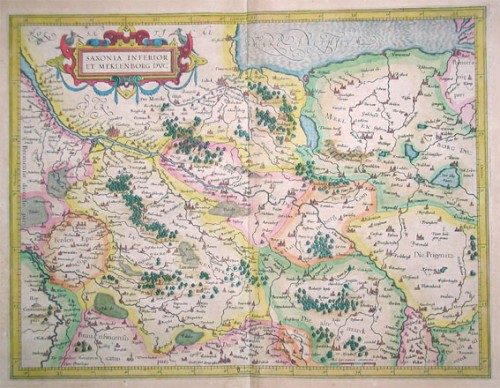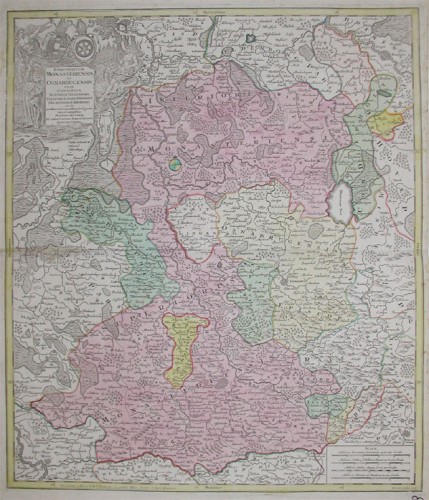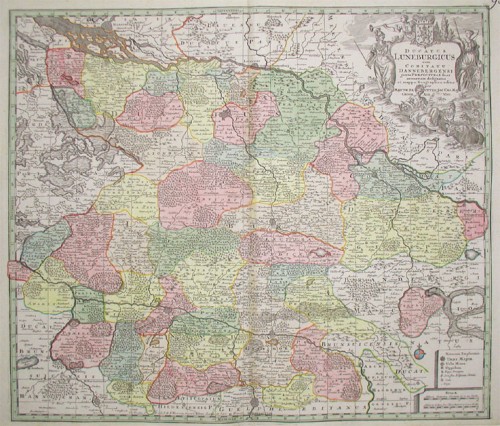Blaeu, Guijelmus & Joan.
Braunschweig
Ducatus Brunsvicensis fereq. Luneburgaensis Cum adjacentibus Episcopatibus, Comit. Domin. etc. Descriptio Geographica,..
Eigenschaften
- Published: Joan. & Guilejemus Blaeu , Amsterdam
- Published date: 1640
- Technique: Copper engraving / Original color.
- Type: Antique Map, map
- Category: Niedersachsen
- Issue date: 1640/50
- Size: 415 by 527mm (16 by 20 inches).
- Stock number: 23207
- Condition: In gutem Erhaltungszustand. 415 by 527mm (16 by 20 inches).
Article description
Article description
Original antique copper engraving, hand colored in outline when published. Kupferstichkarte erschienen in Blaeu's Theatrum. Links unten große alleg. Rollwerkskartusche mit Meilenzeiger u. Wappen. Zeigt detailliert mit vielen Ortsangaben das Herzogtum Braunschweig. Im Norden angrenzend das Herzogtum Lüneburg, im Süden das Eichsfeldt. Im Westen bis Minden u. östl. bis Quedlinburg. Kartenbild mit 6 gestochenen Wappenschildern verziert. Dekorative Karte mit vielen Ortsangaben, die Berge des Harzgebirges schön herausgearbeitet. Original map published in Blaeu's Theatrum. Large alleg. Rollwerk cartouche with miles pointer u. Coat of arms. Shows the Duchy of Braunschweig in detail with many locations. In the north the Duchy of Lüneburg, in the south the Eichsfeldt. To the west to Minden and to the east to Quedlinburg. Map image decorated with 6 engraved heraldic shields. Decorative map with many locations, the mountains of the Harz Mountains worked out nicely. Joan Blaeu (23 September 1596 – 21 December 1673) was a Dutch cartographer born in Alkmaar, the son of cartographer Willem Blaeu. In 1620 he became a doctor of law but he joined the work of his father. In 1635 they published the Atlas Novus (full title: Theatrum orbis terrarum, sive, Atlas novus) in two volumes. Joan and his brother Cornelius took over the studio after their father died in 1638. Joan became the official cartographer of the Dutch East India Company. Blaeu's world map, Nova et Accuratissima Terrarum Orbis Tabula, incorporating the discoveries of Abel Tasman, was published in 1648. This map was revolutionary in that it "depicts the solar system according to the heliocentric theories of Nicolaus Copernicus, which show the earth revolving around the sun.... Although Copernicus's groundbreaking book On the Revolutions of the Spheres had been first printed in 1543, just over a century earlier, Blaeu was the first mapmaker to incorporate this revolutionary heliocentric theory into a map of the world." Blaeu's map was copied for the map of the world set into the pavement of the Groote Burger-Zaal of the new Amsterdam Town Hall, designed by the Dutch architect Jacob van Campen (now the Amsterdam Royal Palace), in 1655. Blaeu's Hollandia Nova was also depicted in his Archipelagus Orientalis sive Asiaticus published in 1659 in the Kurfürsten Atlas (Atlas of the Great Elector). and used by Melchisédech Thévenot to produce his map, Hollandia Nova—Terre Australe (1664). As Joan Blaeu, he also published the 12 volume "Le Grand Atlas, ou Cosmographie blaviane, en laquelle est exactement descritte la terre, la mer, et le ciel". One edition is dated 1663. That was folio (540 x 340 mm), and contained 593 engraved maps and plates. In March 2015, a copy was on sale for £750,000. Around 1649 Joan Blaeu published a collection of Dutch city maps named Toonneel der Steeden (Views of Cities). In 1651 he was voted into the Amsterdam council. In 1654 Joan published the first atlas of Scotland, devised by Timothy Pont. In 1662 he reissued the Atlas Novus, also known as Atlas Maior, in 11 volumes, and one for oceans.[citation needed] A cosmology was planned as their next project, but a fire destroyed the studio completely in 1672. (Wikipedia)Ducatus Brunsvicensis fereq. Luneburgaensis Cum adjacentibus Episcopatibus, Comit. Domin. etc. Descriptio Geographica,..
Recently viewed products






